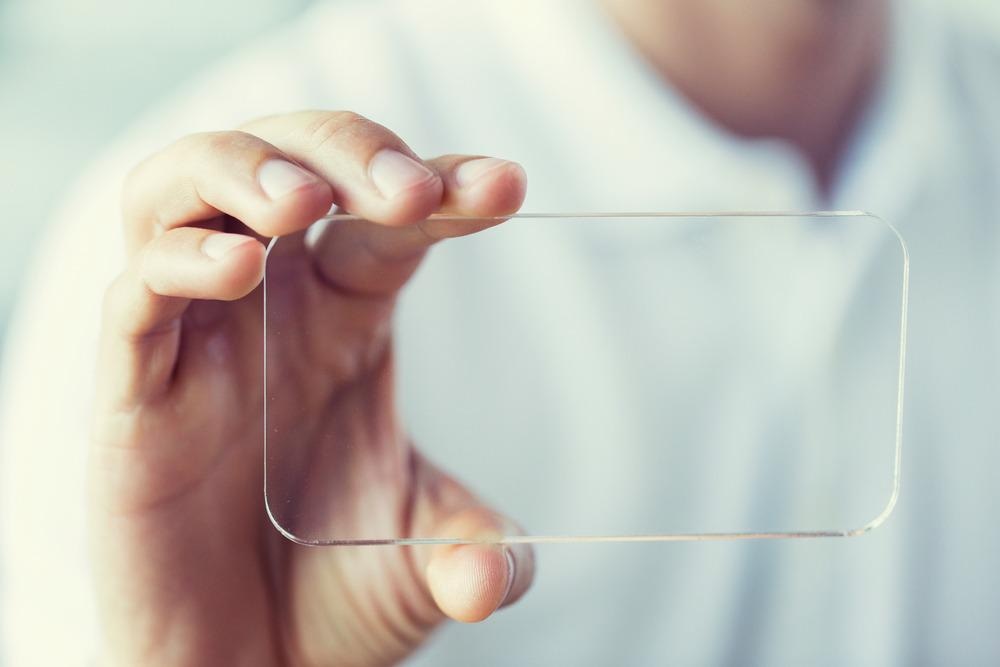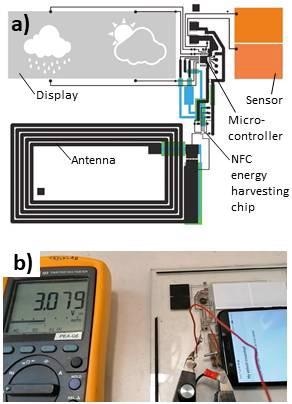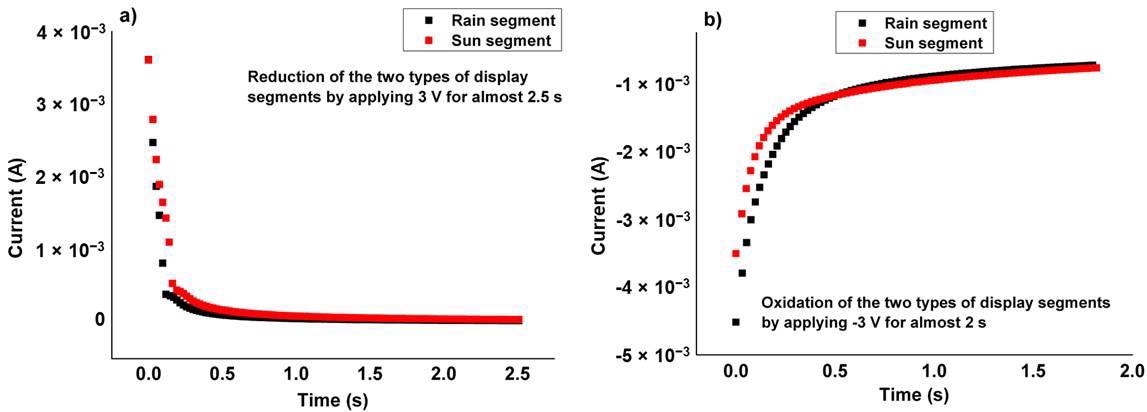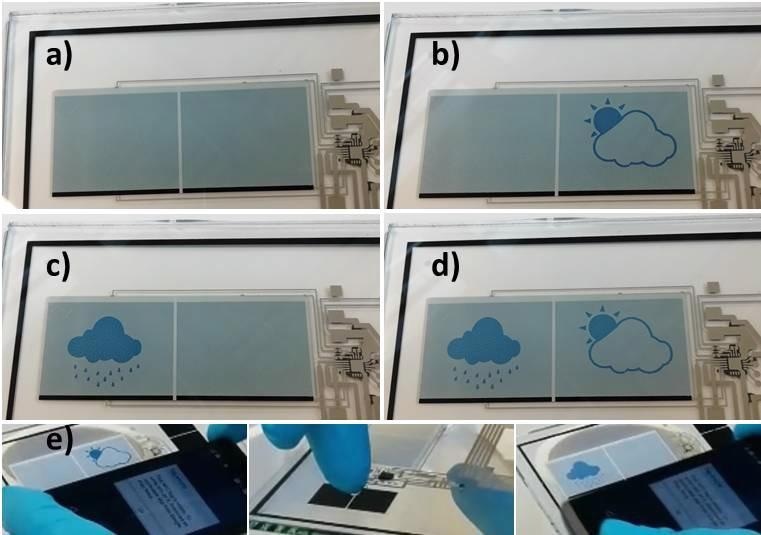A team of researchers based at the RISE Research Institutes of Sweden have developed an innovative method for printing a batteryless hybrid electronics system directly onto glass, published in the journal Electronic Materials. The system incorporates several other components including a sensor capable of detecting water, an electrochromic display, and a silicon chip that harnesses electromagnetic radiation to supply the power.

Study: Batteryless Electronic System Printed on Glass Substrate. Image Credit: Syda Productions/Shutterstock.com
A team of researchers based at the RISE Research Institutes of Sweden have developed an innovative method for printing a batteryless hybrid electronics system directly onto glass. The system incorporates several other components including a sensor capable of detecting water, an electrochromic display, and a silicon chip that harnesses electromagnetic radiation to supply the power.

(a) Schematic showing a few of the screen printed layers: the first silver layer (black), the insulating layer defining the electrochromic “rain” and “sun” display segments (gray), the carbon electrodes of the sensor (orange), the insulating layer required to prevent short-circuits (green), and the second silver layer to establish wire crossings (blue); (b) The continuous voltage output level upon activating the system through the NFC interface of a mobile phone. Image Credit: Andersson Ersman, P et al., Electronic Materials
The system also incorporates a silicon-based microcontroller which monitors the sensor status as well as updates the corresponding display. The RISE team believes this type of energy harvesting system could have application potential in smart window technologies for the automotive and architectural industries.
Printed Electronics
Printed electronics technology is a novel way to fabricate new electronic systems, which is accomplished via standard graphic arts printing processes such as screen printing. As almost any material can be used for this process, the application potential for these systems is wide-ranging as substrates can include materials from paper, plastics, textiles, and even glass.
Therefore, this generation of electronics can be applied to unique, flexible form factors. Additionally, the printing and manufacturing process is relatively low-cost and can be conducted at low temperatures.
While silicon-based electronic systems will still lead the way in terms of powerful processing, performance, and reliability, the potential of printing some systems into almost any shape and/or form at a reduced cost is an extremely exciting prospect. As such, printed electronics are typically regarded as a complement rather than a competitor to traditional electronic systems.
Electro-Glass
While printed electronics can be branded onto almost any material, some materials, such as paper and plastic, are prone to degradation and other environmental effects which in turn compromise the functionality of the system.
Additionally, a number of printed electronics derive from organic molecules and polymers which are also sensitive to environmental conditions and may be prone to the effects of photooxidation and fluctuations in temperature and humidity.
Therefore, printed electronic devices on paper and plastics may benefit from lamination between a barrier film. However, adding barrier films and coatings adds steps to the process which increases costs.

(a) Current vs. time switching behavior upon reduction of the respective display segment by applying 3 V to the counter electrode, i.e., coloration from white to blue. The sharp transitions at ~100–200 ms indicate that the fully reduced semiconducting state has been reached in the PEDOT:PSS electrode. Beyond this time, no further coloration occurs; (b) Current vs. time switching behavior upon oxidation of the respective display segment by applying −3 V to the counter electrode, i.e., the color is switched from blue to white. Image Credit: Andersson Ersman, P et al., Electronic Materials
Therefore, the RISE team identified that glass could be a potential candidate substrate for printed electronics: “Glass belongs to a class of materials that exhibit excellent barrier properties, and another option would therefore be to protect printed electronic devices against the environment by lamination between glass sheets,” explains Peter Andersson Ersman researcher at RISE and co-author of the study.
Glass is an important material in both the automotive and architectural industry and is becoming a fundamental construction material in buildings being used as an aesthetic and practical component. Therefore, adding some level of electronic functionality to glass in buildings could provide added benefits. “Glass is a widely used material… and it can even be flexible,” Ersman said.
One of the current trends in smart glass is electrochromic tintable windows, which can have their opacity controlled by building occupants improving comfort, lifestyle and even reducing energy costs while offering architects more freedom with their designs.
Additionally, tintable smart glass is also finding use in automobiles as it can block out up to 99% of harmful light while maintaining suitable transparency. There is also the potential for windscreens to display crucial information that could enhance the driver experience as well as provide extra safety benefits.
Layer-by-Layer
When fabricating their batteryless electronic system, the RISE team applied a screen printing method on top of float glass substrates with a 4 mm thickness, while the silicon-based components were placed using a pick and place machine.

(a–d) Photographs showing the different coloration states of the screen printed electrochromic display; (e) The photographs describe a demonstration sequence of the system, where the batteryless hybrid printed electronic sensor platform is activated by energy harvesting through the NFC interface of a mobile phone. (Left) A dry sensor state is visualized on the display. (Middle) A water drop is placed on the sensor area. (Right) A wet sensor state is visualized on the display. Image Credit: Andersson Ersman, P et al., Electronic Materials
The layer-by-layer printing approach the researchers implemented required a total of seven screen printing runs to acquire the intended architecture for the system.
The features of the glass substrate, which include good barrier protection against moisture and oxygen make glass a promising material for use in numerous smart glass applications, including practical use in cars and buildings.
Complemented by the pick and place process to affix the silicon components, the RISE team demonstrated that the hybrid layer-by-layer approach and use of glass as a substrate was both inspired and successful for introducing batteryless electronic functionality into a glass substrate.
References
Andersson Ersman, P.; Åhlin, J.; Westerberg, D.; Sawatdee, A.; Arvén, P.; Ludvigsson, M. Batteryless Electronic System Printed on Glass Substrate. Electron. Mater. 2021, 2, 527-535. https://www.mdpi.com/2673-3978/2/4/37
Disclaimer: The views expressed here are those of the author expressed in their private capacity and do not necessarily represent the views of AZoM.com Limited T/A AZoNetwork the owner and operator of this website. This disclaimer forms part of the Terms and conditions of use of this website.